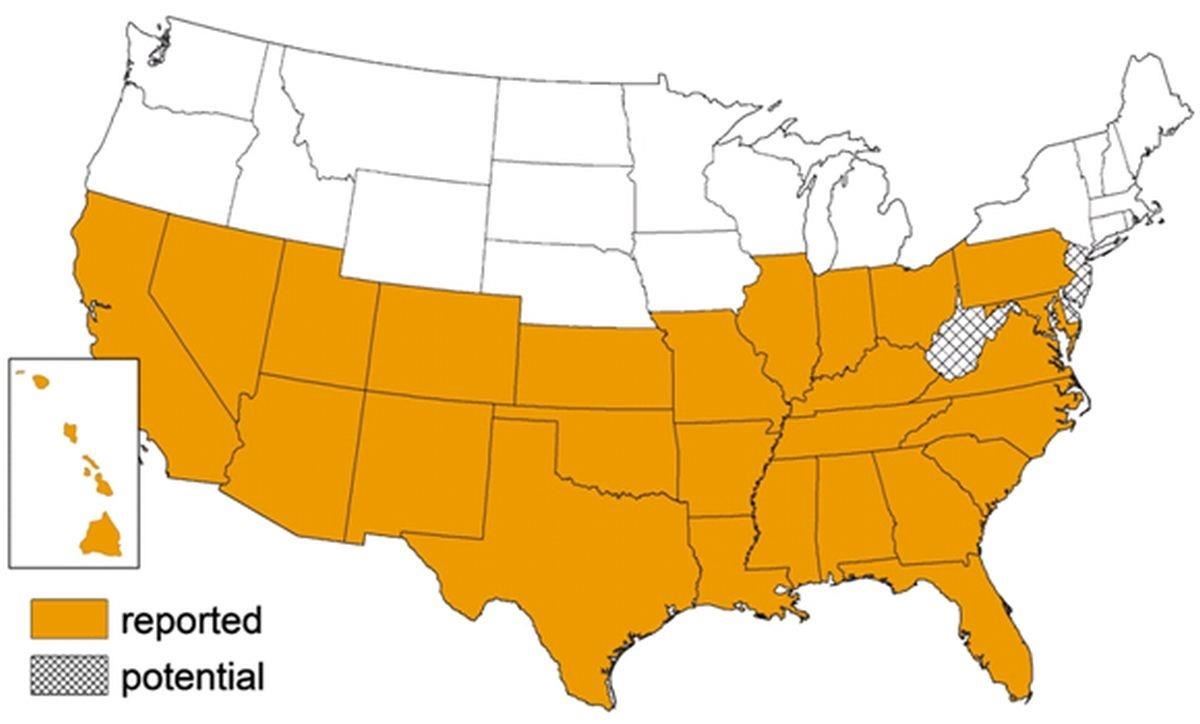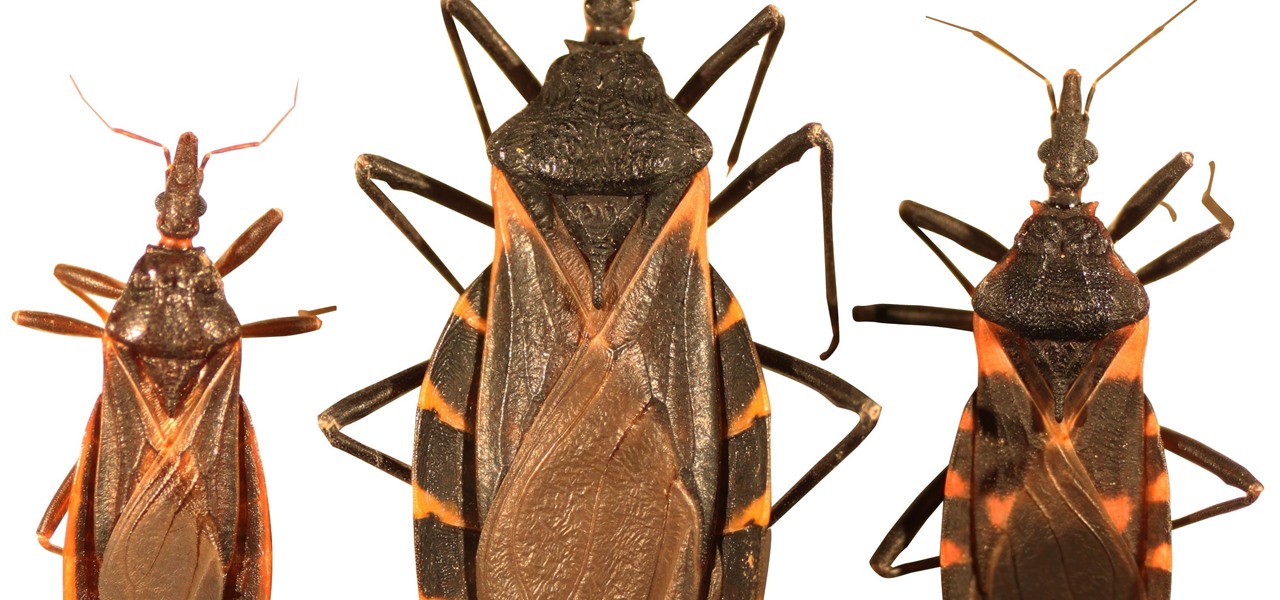Take a close look at the image above. These bugs spread a deadly parasite that infects thousands of people each year. They also live in the US, and it's important to know where they are and whether you need to worry that they're carrying a dangerous infection.
Triatoma bugs are insects that serve as a vector for protozoa called Trypanosoma cruzi. As a vector, that means triatoma insects, more commonly called "kissing bugs," are responsible for the spread of a damaging and devastating disease that occurs when the parasites burrow into their preferred home territory in the human body — the heart muscle. The illness is called Chagas disease, and it's considered a neglected tropical disease— only it doesn't just happen in the tropics.
Spread mostly across the Americas, approximately six to seven million people are infected with T. cruzi, according to the Centers for Disease Control and Prevention. And in the US, between about 300,000 and 1 million people suffer from Chagas disease, and more than 300 babies are born with the parasite each year. The infection can be transmitted from mom to baby, blood transfusion or organ transplant, contaminated food, and laboratory accidents.
A research study published in PLOS Neglected Tropical Diseases studied the cause of death of Chagas victims in Brazil and found that those who tested positive for Chagas disease had more than twice the risk of dying from all causes of death than those without the infection.
Understanding Chagas Disease
Chagas disease is caused not by the bite of the kissing bug, but from its feces. Called the "kissing bug" because it was believed to take its blood meal on, or around, the face, the bug defecates after feeding, leaving its poop on the victim. When the bite becomes itchy, a scratch of a hand from the victim deposits the parasite into the wound — and into the bloodstream.
Infection with Chagas disease occurs in two stages and symptoms can vary from virtually none to extremely serious:
- Acute: Lasting approximately two months, the acute infection occurs just after infection and may seem like a common illness with fever, headache, loss of appetite, aches, and rash. Without treatment, these symptoms will usually subside as the infection becomes chronic.
- Chronic: During the chronic stage, which can last a lifetime, a victim may have no symptoms ever — or not until later in life. The parasite moves to the heart and inhabits the cardiac muscle, potentially causing abnormal heart rhythm or even sudden death. Gastronintestinal complications can occur as well. There is an approximate 30% chance of experiencing these serious impacts.
Treatment with anti-parasite medication in the acute stage of the disease can sometimes rid the body of the T. cruzi protozoa. In the chronic stage, anti-parasitic medications are less effective and treatment shifts to supportive options, like drugs for an irregular heartbeat or a pacemaker.
Digging Through Blood Results in Brazil
In the Brazilian study, researchers from the Department of Infectious Diseases in the School of Medicine at the University of Sao Paulo compared blood donor records with death certificates. About 6,000 people per year die of Chagas disease each year in Brazil.
Because the disease can be transmitted through blood donation, Latin American countries instituted screening of blood donors to stop transmission through blood transfusion. The process identifies Chagas patients who may not know they are infected.
In the study, researchers looked at data from blood donors between 1996 and 2000, and then compared the names and infection status to available death certificates to better understand fatality rates associated with Chagas disease. Findings from the study about Chagas include:
- Out of 1,354,569 blood donors, researchers were able to confirm 2,842 Chagas cases. Of these, 128 people had coinfections like syphilis, hepatitis, or HIV.
- Those with the disease were at 2.3 times higher risk of dying from all causes, than those without the infection.
- Limited to cardiac symptoms, Chagas patients had a "much higher risk" of death than blood donors without Chagas disease.
For the 45 patients with Chagas who died of cardiac symptoms, only 26 had Chagas disease listed as an underlying cause of death. This suggests Chagas fatalities are underreported in Brazil — and possibly wherever Chagas is not recognized as a contributor to heart failure.
The study authors believe most of their subjects suffered chronic infection and were not well-identified for treatment.
Earlier treatment to reduce morbidity and mortality may be important. Chagas is a neglected disease and research is urgently needed in order to test new therapeutic options with fewer side effects and to find better correlates of disease progression.
Chagas Disease in the United States
There are 11 species of kissing bug in the southern half of the US. Mostly inhabitants of the wild — and on wildlife — they pose a greater threat to humans where homes in poor repair allow insects to enter and live within structures inhabited by humans.

In correspondence with Invisiverse, Rachel Curtis-Robles, a doctoral candidate in the Hamer Lab's Kissing Bug Team at Texas A&M University, noted that they have not seen an expansion of the range of kissing bugs in recent years.
If we look back through the scientific literature, we see documentation of kissing bugs in the US as early as the 1800s. A related question we get is whether species have migrated here from south of the border. Again, when looking at the historical scientific literature, this does not appear to have occurred. The species that have been documented in the US have all be documented here for many decades.
With that, a limited research study, also published in PLOS Neglected Tropical Diseases in 2014, predicts the potential for a northward shift in some triatomine species, possibly as a result of climate warming.
Around human settlements, kissing bugs also live near pet housings, or in pet beds, and in and around bedrooms. Like bed bugs, kissing bugs bite and feed at night. Relatively large, the critters can range from ¾" to 1¼" inch length. Most have a striped band around the outside of the body, but nymphs, or younger bugs, may not.

The majority of patients in the US with Chagas disease acquired the disease elsewhere. Still, as recently as 2010, research called for improved testing for the infection in Texas because T. cruzi is endemic to the US.
In addition to documented cases in immigrants who were infected in central and South America, there are increasing reports of human cases of Chagas disease acquired in the US.
Guidance from the US Food and Drug Administration recommends one-time testing of blood donors for T. cruzi. Donors who are unknowingly infected after that initial test are not tested again, potentially allowing contaminated blood into the American blood supply. Surveillance maps reveal Chagas disease impacts Americans from coast to coast.
In a 2015 media interview, Baylor Medical School researcher Dr. Kristy Murray said, "We're finding that more than half of our blood donors actually acquired their infection here, which placed a lot of concern on our minds as to what the real risk is."
Avoid Triatoma Bugs & Avoid Chagas Disease
If you travel to Latin America, be sure to stay in accommodations with screened windows and no evidence of interior infestations. There are no preventative vaccines for Chagas disease.
In the US, kissing bugs are more often found in areas of substandard housing, but are also found in the bush, near cabins, or recreation areas where both humans and wildlife visit. Around your home, consider these steps:
- Seal cracks and crevices where bugs of any kind can enter.
- Remove brush and leaf debris from around your house to discourage rodent nesting and kissing bug infestation.
- Keep pets indoor at night. Dogs can be infected with Chagas, causing severe heart disease.
- Turn off outside lights, which attract flying insects like kissing bugs.
- If you see a kissing bug, do not handle it with your hands or allow others to do so.
Kissing bugs are not a new threat in the US, yet they cause symptoms that sometimes physicians do not recognize in either the acute or chronic stage. Keep your home in good repair and seek medical care if you believe you have suffered an encounter with a kissing bug. It's a matter of heart.
Just updated your iPhone? You'll find new emoji, enhanced security, podcast transcripts, Apple Cash virtual numbers, and other useful features. There are even new additions hidden within Safari. Find out what's new and changed on your iPhone with the iOS 17.4 update.


























1 Comment
Garlic, elephant or regular, raw or fried, but not the bottled stuff found in stores, is effective at assisting the blood pressure, healing infections and eradicating parasites from the body. A teaspoon of cayenne powder mixed into hot water and drank as hot as can be stood is known to stop heart attacks. Because man's remedies are failures, why bother trying to create something to cure and instead use what does work, as mentioned. And, without mixing the natural with man's ineffective quack meds. If there is anyone wanting to wait around until Science has found another false cure, and let those people decide your fate, let the evidence speak for itself...why trust Science and man when it is your life, not theirs, that is at stake.
Share Your Thoughts